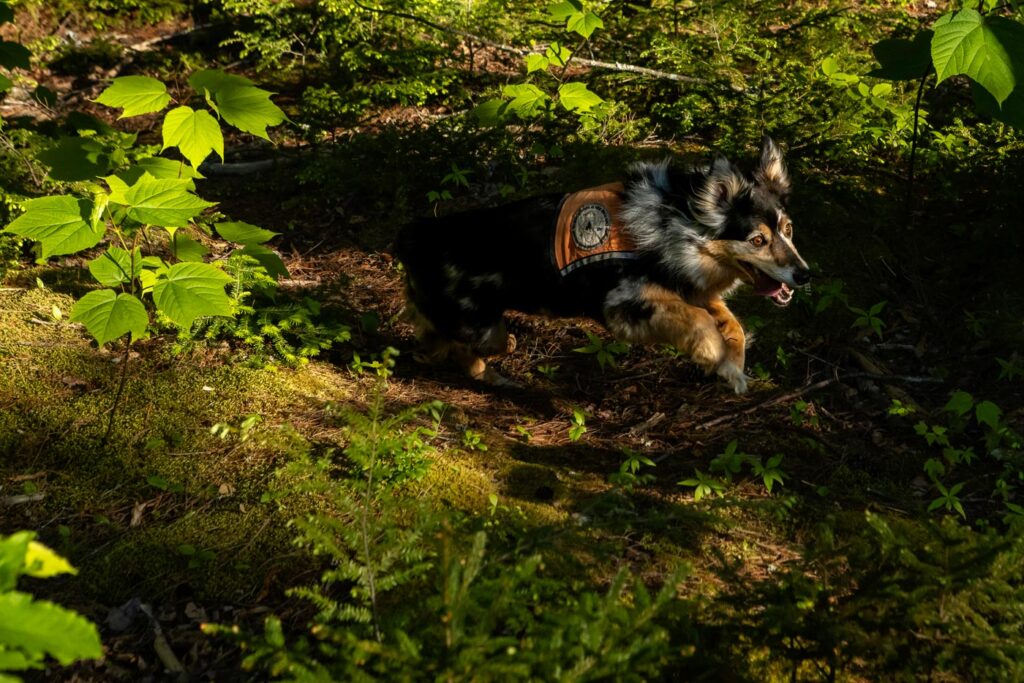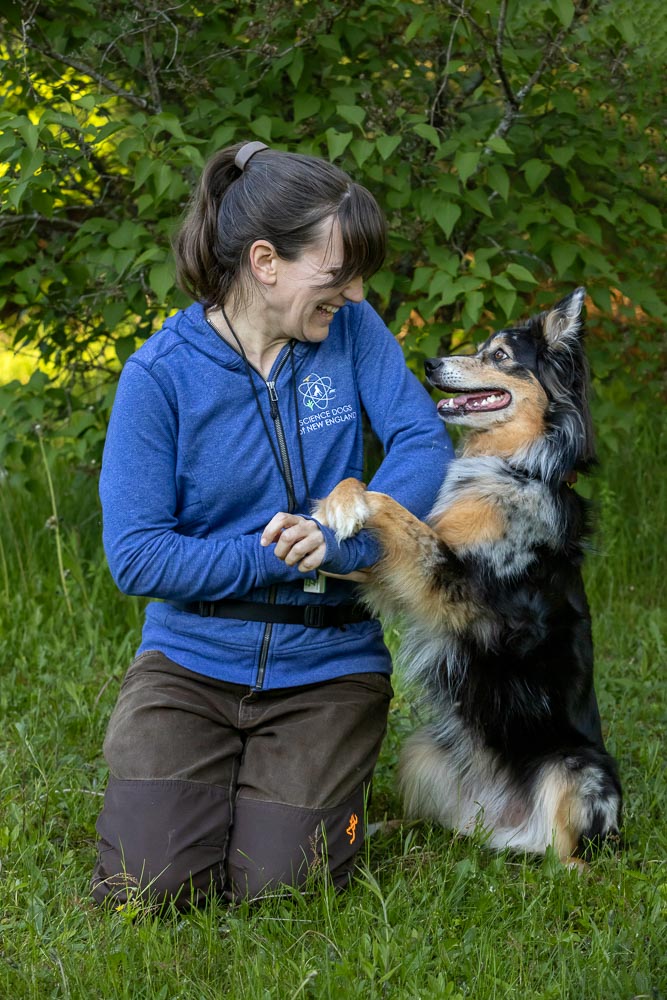By Kathryn Miles
Photos by Ashley L. Conti
From our April 2023 Animals issue
In a lot of ways, Chili Bean is your typical three-year-old Labrador retriever: exuberant, untiring, extremely scent-driven. What distinguishes her from other canines is how she uses these doggy attributes. Chili, as her human friends call her, is a pup with a job, leading scientists and researchers to some of Maine’s most vulnerable animals. She’s one of a growing number of conservation dogs — scent-detection animals trained to locate threatened and endangered species. And in the spring, you’ll find her and her handler, Science Dogs of New England proprietor Lindsay Ware, bushwhacking through Maine’s forests, searching for critically endangered wood turtles.
Once common throughout the Northeast, wood turtle populations plummeted as logging, agriculture, and other human activities wreaked havoc on their habitat, including the streams in which they hibernate each winter. A juvenile wood turtle fits easily in a preschooler’s palm; fully grown specimens typically weigh a little under two pounds. The wood turtle gets its name from the bark-like patterns on its carapace, and that camouflage, along with the turtles’ fondness for hiding in leafy detritus, makes them all but impossible for human researchers to find.

Chili’s keen nose, however, can ferret out even the tiniest turtles, living in some of Maine’s densest woodlands. And researchers hope that each endangered reptile Chili finds gets them closer to saving the species from extinction.
Dogs’ noses — 10,000 to 100,000 times more sensitive than ours — have long been harnessed in amazing ways, sniffing out everything from lost children to explosives to early indicators of diseases. In the early ’90s, some biologists wondered, why not endangered species? Law-enforcement K9 handlers helped train the first science pups. Using a method known as targeting, dogs were taught to identify specific smells and objects and respond in desired ways — just like bird dogs are taught to point at grouse or pheasants. Much of the work of early conservation dogs involved finding scat — already a favorite smell of many domestic dogs. But biologists soon realized the dogs could smell all sorts of useful things: tiny fungi, fish swimming deep in a pond, distant herds of elephants, oceanic poop from critically endangered right whales.
The trick, Ware says, is to make sure the dogs are doing so carefully. “Since we’re dealing with such vulnerable species, the most important training issue is making sure the dogs communicate safely and as noninvasively as possible,” she says. “We need them to tell us they’ve found something without accidentally stepping on it or otherwise harming it.”
Ware, who majored in wildlife biology at Maine’s Unity College, started her career as a dog handler working under Don Hanson, a nationally renowned trainer and co-owner of Bangor’s Green Acres Kennel Shop. Initially, she trained her dogs to help hunters locate wounded game. After learning more about detection dogs doing wildlife-conservation work, she approached two former Unity professors, Matthew Chatfield and Cheryl Frederick, founders of the grant-funded Wood Turtle Project, whose team aims to identify wood turtle habitat and better understand the reptiles’ movement patterns, among other efforts. Data from the Wood Turtle Project helps inform state management plans.
In 2019, the team set out to train Ware’s Australian shepherd, Delta, as a proof-of-concept dog. When it was clear that Delta was a whiz at finding the endangered reptiles, Ware went looking for a puppy she could raise specifically for conservation work. Chili Bean, she says, was a perfect choice. “Chili is an energetic, athletic, highly motivated dog,” Ware says. “She lives by her nose, and she’s always been so intent on following scents she’ll run you into a tree if you’re not careful.”
The challenge was how to train her on a wood turtle’s scent. Because they’re endangered, the turtles can’t be captured or handled without a special permit, so simply keeping one in Ware’s training room wasn’t an option. Instead, Chatfield and Frederick collected scent in the field by carefully rubbing sterile gauze on a wood turtle’s carapace, then sealing the gauze in an airtight container. Each time Chili correctly identified it, she was given a treat or an opportunity to play with her favorite ball.


As the wood turtles emerge from hibernation, Ware and Chili spend upwards of five hours at a stretch traipsing across some of Maine’s most challenging terrain. When Chili finds a turtle, she knows to lie down near it. Ware then logs the location, and Chatfield and Frederick’s team follows up to tag many of the reptiles. Her main job, Ware says, is to keep Chili and her other two detection dogs from working themselves into exhaustion. “Conservation dogs like Chili really love their work,” she says. “It’s like a big game for them.”
Ware has started training Chili to locate wood turtle nests as well, and she’s eager to see how her dogs might help other endangered species. Worldwide, nearly one in four reptiles is at risk of extinction — and they make up just a fraction of more than 40,000 threatened animal and plant species on the “Red List” maintained by the International Union for Conservation of Nature. Luckily, Ware says, conservationists have only just begun to tap into the ways that canines might lend a paw. “Individual conservation dogs have already demonstrated they can be trained to find dozens of different species,” Ware says. “There’s no sign of any limit to their amazing abilities.”




